What is Pavers?
Pavers are slabs and blocks made of several materials, including brick (clay), concrete, flagstone, marble, travertine, porcelain, rubber, and even plastic, used to make driveways, patios, pools decks, and other structures. For such tasks, they can be a very suitable concrete option. Except for some stamped concrete, Pavers look nicer than conventional concrete slabs. Finally, when it comes to paver installation, you have the option of using interlocking or slabs.
They’re employed in various places throughout the house, notably outside. the most typical applications of pavers are:
i) Driveways
ii) Patios
iii) Pool decks
iv) Planters
v) Fire pits
vi) Walkways
Different Types of Pavers:
1. Brick Pavers:
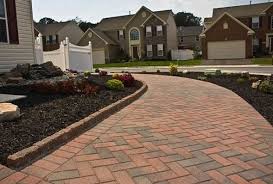
Fig 1: Brick Pavers
Courtesy: landscapingnetwork.com
Brick pavers are often called clay pavers since they are formed of clay and shale material. There are a variety of processes for making brick pavements, but the soft mud approach is the most cost-effective and widely employed. The raw clay is generally blended with 25-30% sand to reduce shrinkage. The mixture is then pressed into steel molds and burned at temperatures ranging from 900 to 1000 degrees Celsius.
The raw materials’ natural properties result in a long-lasting and effective paving product. The hues of the brick pavers are taken from the clay and shale elements used, giving them a natural, long-lasting appearance. Although brick pavers come in various colors, from light to dark earthy red tones, they do not have the same color option as concrete pavers.
2. Concrete Pavers:
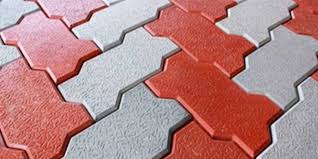
Fig 2: Concrete Pavers
Courtesy: astronspacer.com
A very dry mixture of aggregates, sand, cement, pigments, and dyes makes concrete pavers. The manufacturing procedure varies slightly, but the mixture is generally enclosed in a paver mold with very little water. After that, the mold is pressed and vibrated simultaneously, allowing the water to fix the cement and bind the aggregate.
Concrete floors are being fired in big industrial furnaces by some manufacturers. The finished product is sturdy, and it’s usually suitable for road and even off-road use. Concrete floors have a wide spectrum of colors due to dyes and pigments, albeit the color fades faster than brick and stone pavers. Sealants can aid in the preservation of the color of concrete pavements.
3. Flagstone Pavers:
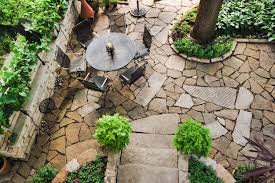
Fig 3: Flagstone Pavers
Courtesy: thespruce.com.com
Flagstone pavers are flat slabs of natural paving stone supplied from a quarry. Slate, limestone, or sandstone are commonly used as flagstone because these natural stones are easy to cut and break into slabs. Brick and concrete pavers, on the other hand, are manufactured at a paving factory. Flagstone pavers are most commonly used in residential settings. Walkways, patios, stepping stones, and pool decks are just a few of the applications.
These pavers are available in a wide range of shapes and colors. Browns, blues, reds, and mixtures of these colors are among the colors used. These pavers are likewise unevenly formed and are square or rectangular. Flagstone pavers range in thickness from 1 to 3 inches, depending on their intended use.
Versatility, high density, safety, durability, low maintenance, ease of installation, and aesthetic appeal are just a few of the benefits of these pavers. Flagstone pavers are versatile since they are acid-resistant and set directly on the soil. These pavers can be utilized both outside and indoors without concrete or aggregate.
4. Bluestone Pavers:
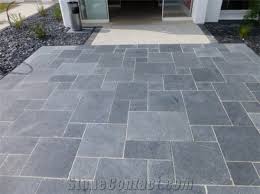
Fig 4: Bluestone Pavers
Courtesy: stonecontact.com
Bluestone pavers are ideal for patios, courtyards, and walks because they are long-lasting and attractive. This attractive paver has a subtly textured surface and large proportions, making it a robust, long-lasting, and eye-catching addition to any outdoor project. Oversized edge spacers generate a bigger joint, which mimics the appearance of genuine stone.
Other pavement materials can combine with bluestone. It’s extremely tough and can be molded into whatever shape you want. Bluestones are available in various colors, with royal blue being one of the most distinctive and attractive.
5. Marble Pavers:
Marbles are one of the most costly and attractive pavers available; they also come in various patterns and may be utilized for commercial and residential applications. It is made of limestone and has an exquisite appearance.
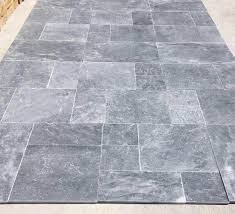
Fig 5: Marble Pavers
Courtesy: stoneadd.com
The tumbled texture of marble pavers makes them less slippery and excellent for outdoor use. Your walks, driveway, patio, and deck will be safer to walk or drive on due to this. Even on a hot day, marble remains cold to the touch since it is a natural stone. Consider pavers in a darker color if you’re going to use them on your driveway to hide stains like oil. Because marble is thick, it can resist heavy traffic. The material is simple to maintain and does not require sealing, making it almost maintenance-free.
6. Travertine Pavers:
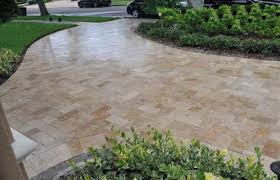
Fig 6: Travertine Pavers
Courtesy: sefaston.com
Travertine pavers, like marble pavers, are all-natural and environmentally beneficial pavers utilized in various applications. These sedimentary rocks originated and grew in response to variations in pressure and temperature. Travertine flooring was a popular choice for outdoor landscaping and flooring because of its natural charm. Patios, worktops, pool areas, and even indoor flooring look great with it.
It comes in a variety of colors and is less expensive than marble. Travertine pavers are extremely long-lasting and do not discolor. It insulates heat, which is why it keeps the room cool throughout the summer. Because it is so much heavier, the cost of the building rises as well. It is particularly sensitive to acids and reveals some undesirable strains.
7. Cobblestone Pavers:
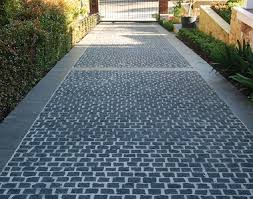
Fig 7: Cobblestone Pavers
Courtesy: pavers.melbourne
Granite is the most common material for cobblestone pavers, but it can also form basalt, limestone, or sandstone. This paper type has been used for decades, demonstrating its strength and durability. Cobblestone pavers offer the best of both worlds: long-term durability and attractive aesthetics.
It is a highly long-lasting product that requires very little care, only two or three times per year on average. It is available in a variety of colors on the market. Cobblestone paver installation is a time-consuming and labor-intensive process. These pavers are overly pricey in comparison to other pavers.
8. Porcelain Pavers:
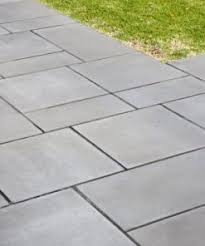
Fig 8: Porcelain Pavers
Courtesy: carmelimports.com
Porcelain is a clay-based material that undergoes intense heat treatment. This procedure yields a non-porous, rigid, and long-lasting product. Porcelain pavers can be used indoors and outside; however, they absorb less than other porous materials. They are mostly employed in damp places like pool decks.
Porcelain pavers are less expensive than other pavers since they are created from natural materials such as granite, slate, and marble. It doesn’t require a lot of upkeep, and cleaning it is also a breeze. It comes in a variety of colors and absorbs less moisture. Porcelain is not ideal for a driveway in areas where the weather is extreme, such as frost.
9. Rubber Pavers:
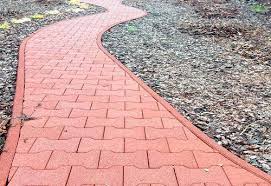
Fig 9: Rubber Pavers
Courtesy: tradeindia.com
Rubber pavers are a relatively new product on the market, with the bulk of them being constructed from recycled materials. These are incredibly tough and resistant to wear and tear. They compete with brick and concrete pavers, which have their advantages. On the other hand, Rubber pavers are the simplest to replace and install compared to other pavers.
Although brick and concrete pavers are more aesthetically beautiful and do not fade as rapidly in direct sunlight as rubber patio pavers, they are a more cost-effective, environmentally responsible, and long-lasting option when compared to other patio pavers.
10. Plastic Pavers:
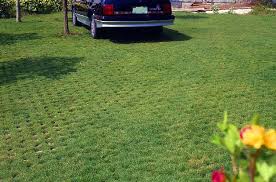
Fig 10: Plastic Pavers
Courtesy: exportersindia.com
Plastic pavers can be either newly created or recycled from plastic trash, which is more efficient. This ground-breaking process involves melting the plastic with water and mixing it with the soil. After that, the material is blended and poured into paved containers to dry. This notion was developed by environmentalists to address the global proliferation of so many plastic products.
Conclusion:
There are various pavers to choose from when building a patio, walkway, or even a pool surround. Not only for aesthetic reasons but also for the sake of longevity, selecting the proper paver stone is critical. Some pavers are more resistant to particular elements, while others are easier to maintain.
References:
1. Paving Blocks – Globmac. (2021, July 26). Globmac; www.globmac.com. https://www.globmac.com/en/paving-blocks/
2. Types Of Pavers: Materials and Colors | African Pegmatite. (2020, January 20). African Pegmatite; mineralmilling.com. https://mineralmilling.com/types-of-pavers-materials-and-colours/
3. Staff & Writers, H. E. (2018, July 27). 19 Types of Pavers for Your Driveway, Patio, Walkway and More – Home Stratosphere. Home Stratosphere; www.homestratosphere.com. https://www.homestratosphere.com/paver-types/
4. Gundaraniya, N. (2022, February 2). Different Types of Pavers for Driveways. CivilJungle; civiljungle.com. https://civiljungle.com/different-types-of-pavers-for-driveways/
5. 11+ Types of Pavers (for Driveway, Patio & Pool Deck) | Upgraded Home. (2021, February 11). Upgraded Home; upgradedhome.com. https://upgradedhome.com/types-of-pavers/
6. Paver Blocks – Types, Shapes, Uses, and Benefits – The Constructor. (2020, March 10). The Constructor; theconstructor.org. https://theconstructor.org/building/paver-blocks-types-shapes-uses-and-benefits/39188/
If you have a query, you can ask a question here.


